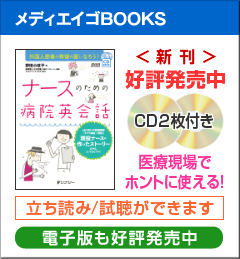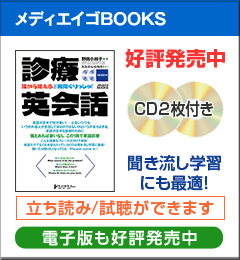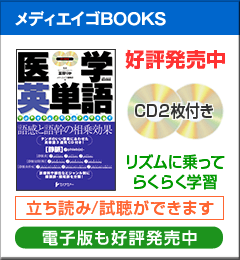

医学にも詳しいバイリンガル・パーソナリティのスマイリーが,ホットな話題を英語のニュースリリースを元に紹介する音声(ポッドキャスト)番組です。完全なネイティブではない,ちょっとくせのあるパワフル英語がやみつきになるかもしれませんよ。番組で取り上げるニュースリリースの全文も掲載しているので,ぜひご活用ください。
英語と日本語のチャンポンで不定期にお届けします。
Please enjoy this bilingual news program!
※iPhone, iPadでは「Download」をタップすると音声が出ます。
Jun. 25, 2012
No. 3
米国心臓病学会より:胸痛の鑑別診断 ~後編~
救急外来で行う急性冠症候群の鑑別診断に冠動脈CT検査が有用(ROMICAT II試験)
――試験デザインと主な結果
|
Get the Flash Player to see this player.
|
 |
・enroll:登録する
・symptom:症状
・electrocardiogram:心電図
【番組で取り上げた英文】
The study enrolled patients who arrived in the emergency room (ER) with chest pain and who were at intermediate risk for a heart attack based on their symptoms and initial ER evaluation, which included blood tests and electrocardiogram results.
Patients were randomly assigned to receive either a CT scan as their first diagnostic test or standard care, which could include a cardiac stress test or no tests at all, depending on the patient’s situation and physician preference.
The results showed that using CT scans to evaluate patients with chest pain in the ER reduced their average time spent in the hospital by 18 hours. Half of the patients receiving the CT scan were safely discharged within nine hours compared to only 15 percent of patients receiving standard care.
The use of CT resulted in 10 percent to 20 percent cost savings to the ER over standard care.
It shows that cardiac CT is ready for use in a pragmatic health care setting, as it is more effective than the standard ER evaluation.
【ニュースリリース全文】 ※番組で取り上げた箇所は太字になっています。
News Release from American College of Cardiology (CardioSource) on March 27, 2012
CARDIAC CT IS FASTER, MORE EFFECTIVE FOR EVALUATING PATIENTS WITH SUSPECTED HEART ATTACK
CHICAGO (March 27, 2012) — Cardiac computed tomography angiography scans (CT scans that look at the heart) can provide a virtually instant verdict on whether chest pain is from blockage of the coronary arteries. When used early to evaluate chest pain, the scans save patients and hospitals time and money by allowing doctors to quickly determine who should be admitted for treatment for a heart attack and who can be safely sent home, according to research presented today at the American College of Cardiology’s 61st Annual Scientific Session. The Scientific Session, the premier cardiovascular medical meeting, brings cardiovascular professionals together to further advances in the field.
The ROMICAT II study involved 1,000 patients at nine hospitals across the United States. The results showed that using CT scans to evaluate patients with chest pain in the emergency room (ER) reduced their average time spent in the hospital by 18 hours. Half of the patients receiving the CT scan were safely discharged within nine hours compared to only 15 percent of patients receiving standard care. The use of CT resulted in 10 percent to 20 percent cost savings to the ER over standard care.
“These data suggest that doing a CT scan early benefits both patients and physicians,” said Udo Hoffmann, MD, MPH, director of cardiac imaging at Massachusetts General Hospital and the study’s lead investigator. “Physicians benefit because they can discharge many patients from the overcrowded ER very quickly, with solid reassurance that they’re not having a heart attack, while the standard evaluation takes much longer to assess whether the symptoms stem from blockages in their arteries. Patients benefit from an earlier diagnosis and can safely go home from the ER earlier.”
About 6 million people come to hospital ERs in the United States each year complaining of chest pain, but only a fraction are actually having a heart attack or other major cardiac problems. Under the current standard of care, most individuals are observed in the hospital for one or two days and may be given one of several cardiac stress tests to assess their heart’s health. Cardiac CT scans allow doctors to quickly use X-ray images of the heart to identify whether a patient has blocked arteries or other cardiac problems.
The study enrolled patients who arrived in the ER with chest pain and who were at intermediate risk for a heart attack based on their symptoms and initial ER evaluation, which included blood tests and electrocardiogram results. Patients were randomly assigned to receive either a CT scan as their first diagnostic test or standard care, which could include a cardiac stress test or no tests at all, depending on the patient’s situation and physician preference.
Because healthy patients were discharged much earlier and often needed just a CT scan and a single blood test, their health care costs were lower. “It looks like CT saves time and money for the health care system in those who have no blockages in their coronary arteries. Though only a modest amount of money is saved per patient, it may save a lot of money considering the millions of patients affected across the country,” Dr. Hoffmann said. “CT allows you to spend your health care dollars focusing on the people who are actually sick. One could argue that this is a better use of health care resources.”
CT scans also provide useful prognostic information that doctors can refer back to if the patient experiences chest pain again. “If their CT scan shows clear heart arteries, we know from our previous ROMICAT I study that their prognosis over the next two years is really good, which can be useful farther down the road,” Dr. Hoffmann said.
Other studies have offered somewhat conflicting assessments of the efficiency and effectiveness of using CT scans as the first diagnostic test for chest pain. This trial is unique because the CT scan was done much earlier in the evaluation process compared to other studies and was used in a real-life setting. Moreover, this was the first trial to show that physicians could act on the information from the CT scan in a way that improved a measure of care – safe earlier discharge – after ER presentation for chest pain. “It shows that cardiac CT is ready for use in a pragmatic health care setting, as it is more effective than the standard ER evaluation,” said Dr. Hoffmann.
This study was funded by the National Heart, Lung, and Blood Institute of the National Institutes of Health.



